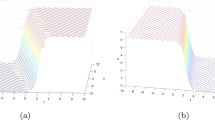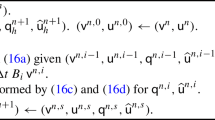Abstract
A Neumann series of Bessel functions (NSBF) representation for solutions of Sturm–Liouville equations and for their derivatives is obtained. The representation possesses an attractive feature for applications: for all real values of the spectral parameter \(\omega \) the estimate of the difference between the exact solution and the approximate one (the truncated NSBF) depends on N (the truncation parameter) and the coefficients of the equation and does not depend on \(\omega \). A similar result is valid when \(\omega \in {\mathbb {C}}\) belongs to a strip \(\left| \hbox {Im }\omega \right| <C\). This feature makes the NSBF representation especially useful for applications requiring computation of solutions for large intervals of \(\omega \). Error and decay rate estimates are obtained. An algorithm for solving initial value, boundary value or spectral problems for the Sturm–Liouville equation is developed and illustrated on a test problem.



Similar content being viewed by others
References
Abramovitz, M., Stegun, I.A.: Handbook of Mathematical Functions. Dover, New York (1972)
Baricz, A., Jankov, D., Pogány, T.K.: Neumann series of Bessel functions. Integral Transforms Spec. Funct. 23(7), 529–538 (2012)
Barnett, A.R.: The calculation of spherical Bessel and Coulomb functions. In: Bartschat, K. (ed.) Computational Atomic Physics, p. 249. Springer, Berlin (1996). ISBN 3-540-60179-1
Camporesi, R., Di Scala, A.J.: A generalization of a theorem of Mammana. Colloq. Math. 122(2), 215–223 (2011)
DeVore, R.A., Lorentz, G.G.: Constructive Approximation. Springer, Berlin (1993)
Everitt, W.N.: A catalogue of Sturm–Liouville differential equations. In: Theory, Sturm-Liouville (ed.) Past and Present, pp. 271–331. Birkhäuser, Basel (2005)
Gillman, E., Fiebig, H.R.: Accurate recursive generation of spherical Bessel and Neumann functions for a large range of indices. Comput. Phys. 2, 62–72 (1988)
Kamke, E.: Handbook of Ordinary Differential Equations. Moscow: Nauka (1976). (Russian translation from the German original, Differentialgleichungen. Lösungsmethoden und Lösungen. Leipzig, 1959)
Khmelnytskaya, K.V., Kravchenko, V.V., Rosu, H.C.: Eigenvalue problems, spectral parameter power series, and modern applications. Math. Methods Appl. Sci. 38, 1945–1969 (2015)
Kravchenko, V.V.: A representation for solutions of the Sturm–Liouville equation. Complex Var. Elliptic Equ. 53, 775–789 (2008)
Kravchenko, V.V., Morelos, S., Torba, S.M.: Liouville transformation, analytic approximation of transmutation operators and solution of spectral problems. Appl. Math. Comput. 273, 321–336 (2016)
Kravchenko, V.V., Morelos, S., Tremblay, S.: Complete systems of recursive integrals and Taylor series for solutions of Sturm–Liouville equations. Math. Methods Appl. Sci. 35, 704–715 (2012)
Kravchenko, V.V., Navarro, L.J., Torba, S.M.: Representation of solutions to the one-dimensional Schrödinger equation in terms of Neumann series of Bessel functions Appl. Math. Comput. 314, 173–192 (2017)
Kravchenko, V.V., Porter, R.M.: Spectral parameter power series for Sturm–Liouville problems. Math. Methods Appl. Sci. 33, 459–468 (2010)
Castillo-Pérez, R., Kravchenko, V.V., Torba, S.M.: A Neumann series of Bessel functions representation for solutions of perturbed Bessel equations. Appl. Anal. 28 (2017). https://doi.org/10.1080/00036811.2017.1284313
Kravchenko, V.V., Torba, S.M.: Modified spectral parameter power series representations for solutions of Sturm–Liouville equations and their applications. Appl. Math. Comput. 238, 82–105 (2014)
Kravchenko, V.V., Torba, S.M.: Analytic approximation of transmutation operators and applications to highly accurate solution of spectral problems. J. Comput. Appl. Math. 275, 1–26 (2015)
Kravchenko, V.V., Torba, S.M.: Analytic approximation of transmutation operators and related systems of functions. Bol. Soc. Mat. Mex. 22, 379–429 (2016)
Levitan, B.M.: Inverse Sturm–Liouville Problems. VSP, Zeist (1987)
Marchenko, V.A.: Sturm–Liouville Operators and Applications, Revised edn. AMS Chelsea Publishing, Providence (2011)
Marchenko, V.A.: Some questions on one-dimensional linear second order differential operators. Trans. Mosc. Math. Soc. 1, 327–420 (1952)
Trimeche, K.: Transmutation Operators and Mean-Periodic Functions Associated with Differential Operators. Harwood Academic Publishers, London (1988)
Watson, G.N.: A Treatise on the Theory of Bessel Functions. Reprinted, 2nd edn. Cambridge University Press, Cambridge (1996)
Wilkins, J.E.: Neumann series of Bessel functions. Trans. Am. Math. Soc. 64, 359–385 (1948)
Zwillinger, D.: Handbook of Differential Equations. Academic Press, New York (1997)
Author information
Authors and Affiliations
Corresponding author
Additional information
Research was supported by CONACYT, Mexico via the Projects 166141 and 222478.
Error and decay rate estimates
Error and decay rate estimates
In this appendix some estimates for the functions \(\varepsilon _{N}\) and \(\varepsilon _{1,N}\) from Theorems 3.1 and 3.2 are presented. Also decay rate estimates and bounds near \(x=0\) for the coefficients \(\beta _{n}\) and \(\gamma _{n}\) are obtained in dependence on the smoothness of the potential Q. The estimates are from [13] with some additional improvements obtained using ideas from [15].
It is well known (see, e.g., [19,20,21,22]) that the solutions \(c(\omega ,x)\) and \(s(\omega ,x)\) of (2.3) satisfying the initial conditions (3.1) can be represented as
and
i.e., as images of the functions \(\cos \omega t\) and \(\sin \omega t\) under the action of the so-called transmutation operator T. This operator is defined on an arbitrary integrable function by the rule
Its integral kernel K satisfies the equalities
and the derivative \(\partial _{x}K=:K_{1}\) satisfies the equalities (see [18])
The integral kernel K is one degree smoother than the potential Q. To be more precise, let \(Q\in W_{\infty }^{p}[0,b]\), \(p\ge 0\), i.e., the function Q possesses p derivatives, the last one belonging to \(L_{\infty }(0,b)\). In such case the integral kernel K possesses \(p+1\) derivative with respect to each variable. In particular, for each \(x>0\), \(K(x,\cdot )\in W_{\infty } ^{p+1}[-x,x]\) and the norms \(\Vert \partial ^{p+1}_{t} K(x,t)\Vert _{L_{\infty } (-x,x)}\) are bounded on [0, b].
The following result shows that the coefficients \(\beta _{n}\) and \(\gamma _{n}\) defined by (3.4) and (3.11) are the Fourier–Legendre coefficients of the integral kernel K and its derivative \(K_{1}:=\partial _{x} K\), respectively.
Theorem A.1
[13] Let \(Q\in L_{\infty }(0,b)\). The transmutation kernel K and its derivative \(K_{1}\) have the form
here \(P_{n}\) denotes the classical Legendre polynomials. The coefficients \(\beta _{n}\) and \(\gamma _{n}\), \(n\ge 0\), can be recovered using the formulas
Denote by \(K_{N}\) and \(K_{1,N}\) partial sums of the series (A.4). Let \(Q\in W_{\infty }^{p}[0,b]\), \(p\ge 0\). Define
As was mentioned earlier, both suprema exist and are finite numbers. The following convergence rate estimates hold.
Proposition A.2
Let \(Q\in W_{\infty }^{p}[0,b]\), \(p\ge 0\). Then there exist constants \(c_{p}\) and \(d_{p}\) independent of Q and N, such that for all \(x>0\) the following inequalities hold
and
Proof
Let \(x>0\) be fixed. Consider functions \(g(z):=K(x,xz)\) and \(g_{N} (z):=K_{N}(x,xz)\) defined on \([-1,1]\). The function \(g_{N}\) is a partial sum of the Fourier–Legendre series for the function g, hence \(g_{N}\) coincides with the N-th order polynomial best \(L_{2}\) approximation of the function g. Since the integral kernel K possesses \(p+1\) derivatives with respect to the second variable with the last derivative belonging to \(L_{\infty }(-x,x)\), we have that \(g\in W_{\infty }^{p+1}[-1,1]\subset W_{2}^{p+1}[-1,1]\). Theorem 6.2 from [5] states that there exists a universal constant \(\tilde{c}_{p}\) such that for every \(N>p+1\)
where \(\omega \) is the modulus of continuity.
By the definition \(g^{(p+1)}(z) = x^{p+1} \partial _{t}^{p+1}K(x,t)\big |_{t=xz} =:x^{p+1} K_{2}^{(p+1)}(x,xz)\), hence
where we used that \(\Vert K_{2}^{(p+1)}(x,x\cdot )\Vert _{L_{2}(-1,1)}\le \sqrt{2}M\) due to (A.6).
The second estimate (A.8) can be obtained similarly. \(\square \)
Estimates (A.7) and (A.8) provide upper bounds for the error functions \(\varepsilon _{N}\) and \(\varepsilon _{1,N}\) from Theorems 3.1 and 3.2. Indeed, the approximate solutions \(c_{N}\) and \(s_{N}\) are obtained by changing K by \(K_{N}\) in (A.1). Hence by the Cauchy-Schwarz inequality we have
for any \(\omega \in \mathbb {R}\). The estimates for the function \(\varepsilon _{1,N}\) follows similarly by using corresponding estimates for the derivative \(K_{1}\).
The following proposition provides estimates of the decay rate of the coefficients \(\beta _{k}\) and \(\gamma _{k}\) and their behavior near \(x=0\).
Proposition A.3
Let \(Q\in W_{\infty }^{p}[0,b]\), \(p\ge 0\). There exist constants \(C_{p}\) and \(D_{p}\) (independent of N) such that
and
Proof
We obtain using (A.5) and (A.7), the fact that the Legendre polynomial \(P_{n}\) is orthogonal to any polynomial of degree less than N and the Cauchy-Schwarz inequality that
The proof of the second estimate (A.11) is similar. \(\square \)
The following bound for the behavior of the first coefficients near \(x=0\) is valid.
Corollary A.4
Let \(Q \in W_{\infty }^{p}[0,b]\), \(p\ge 0\). Then
where \(c_{n}\) and \(d_{n}\) are some constants dependent on Q.
Sufficient conditions for the smoothness of the transformed potential Q in terms of the coefficients p, q and r can be easily obtained from (2.4).
Rights and permissions
About this article
Cite this article
Kravchenko, V.V., Torba, S.M. A Neumann series of Bessel functions representation for solutions of Sturm–Liouville equations. Calcolo 55, 11 (2018). https://doi.org/10.1007/s10092-018-0254-7
Received:
Accepted:
Published:
DOI: https://doi.org/10.1007/s10092-018-0254-7
Keywords
- Sturm-Liouville equation
- Liouville transform
- Neumann series of Bessel functions
- Transmutation operator
- Approximate solution




